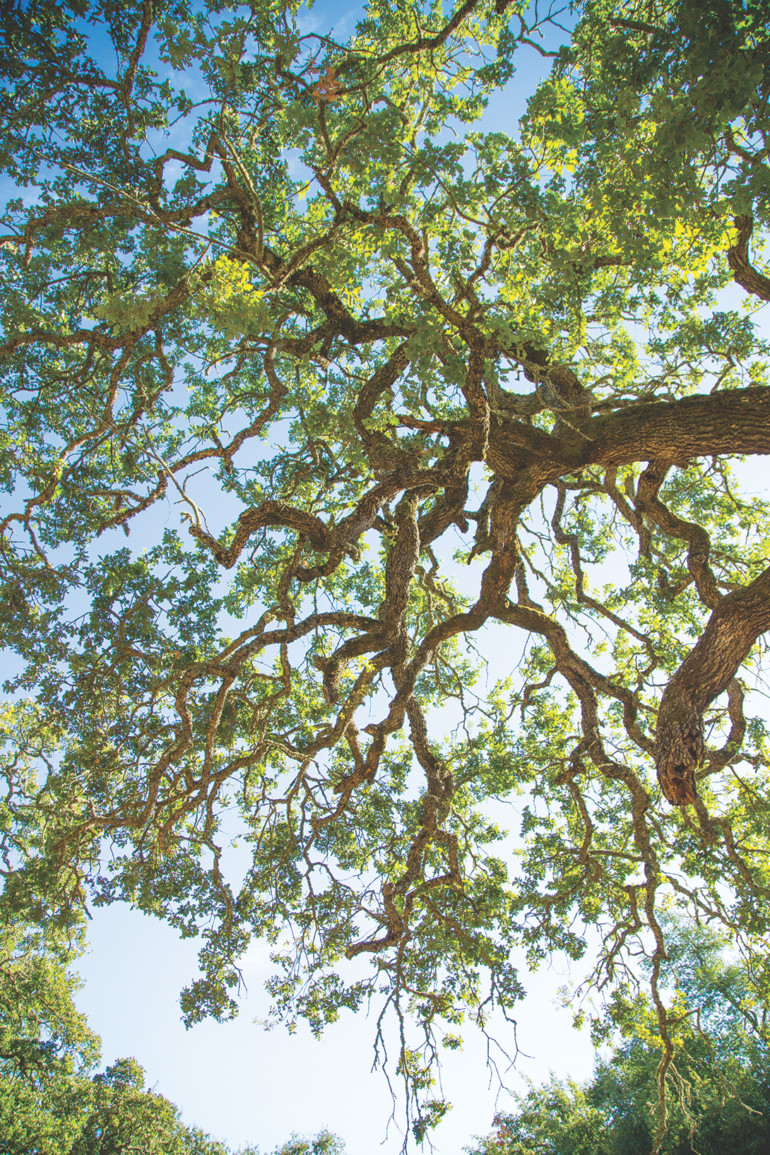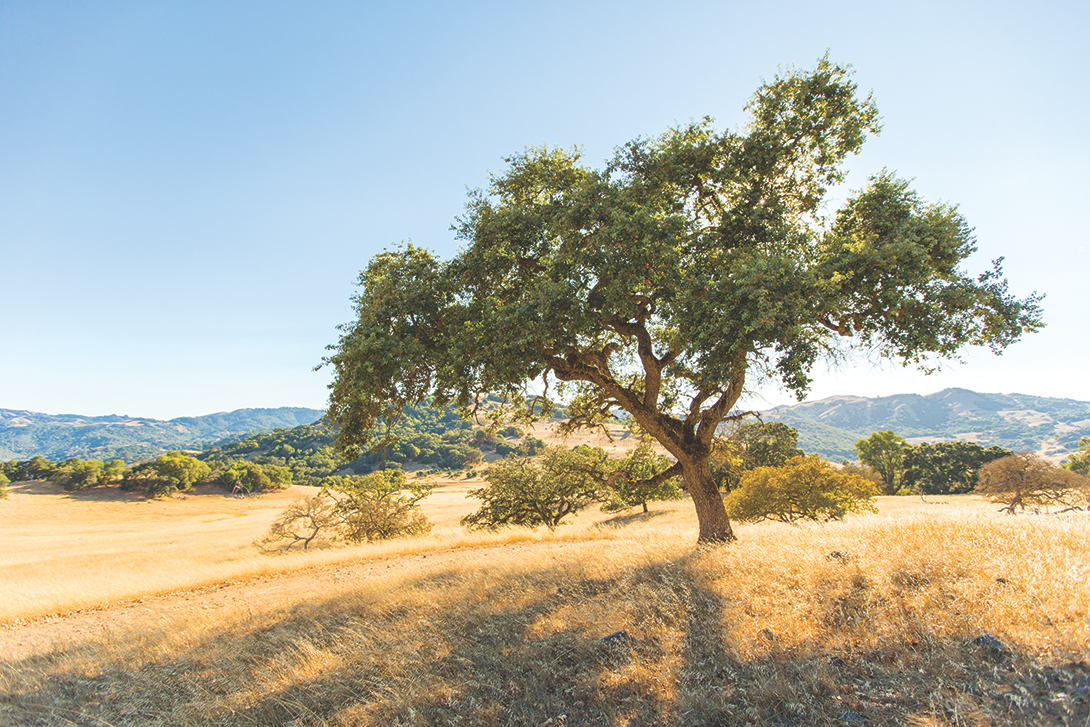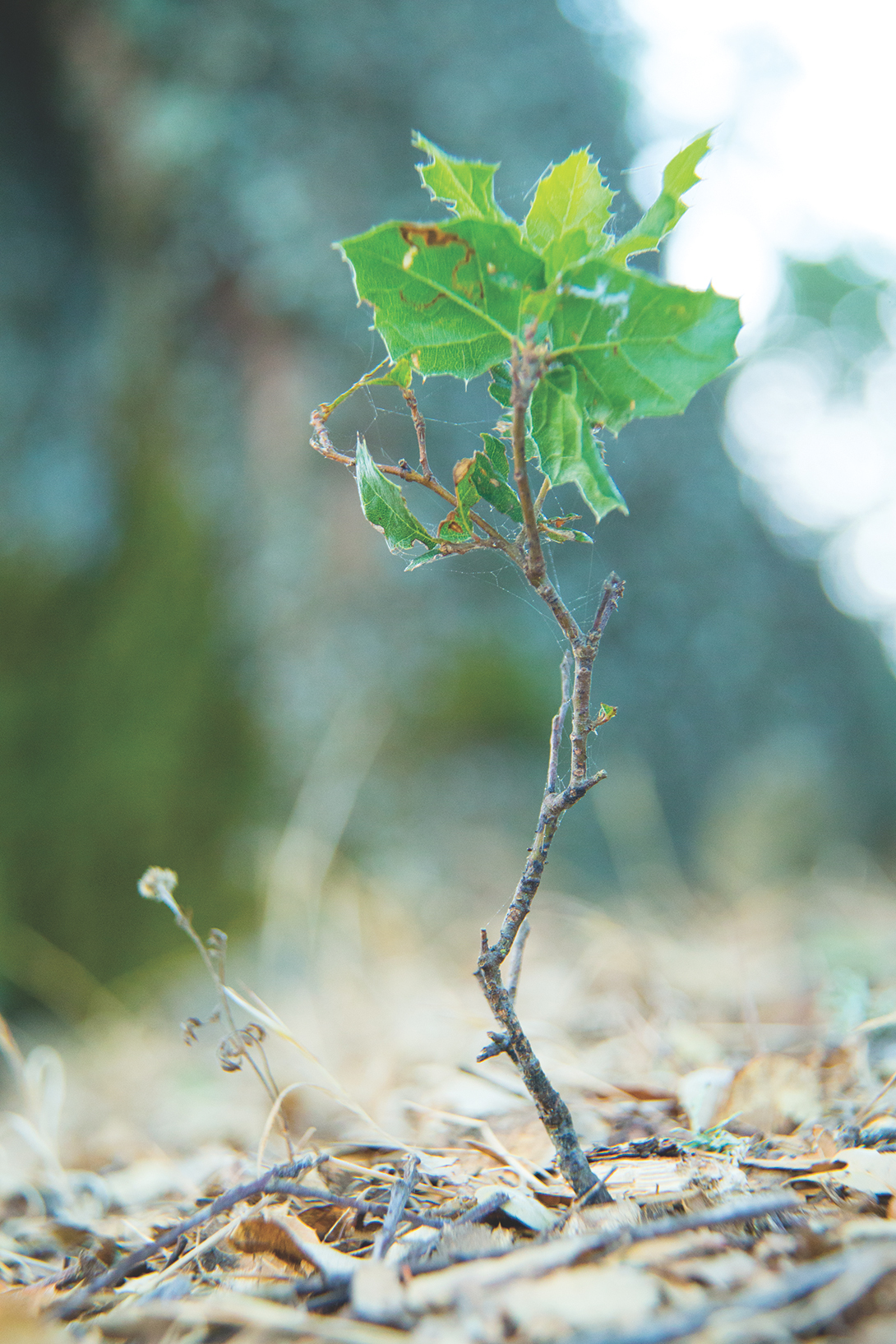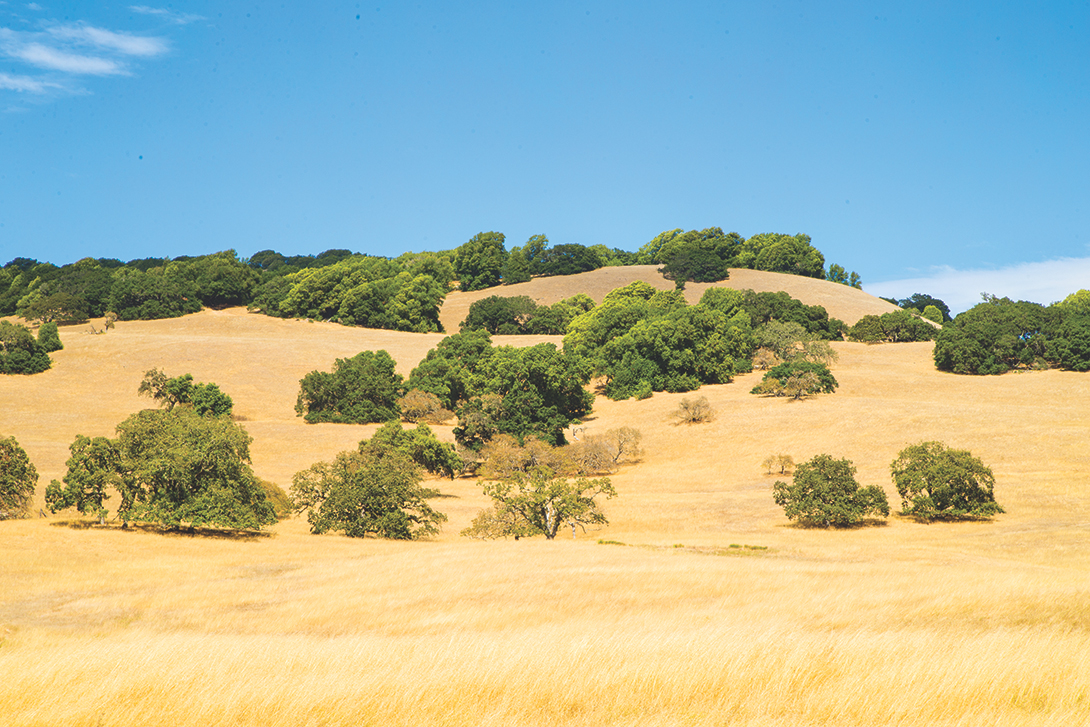Oaks tell stories.
Where different species choose to live can tell you how hot or cool an area is, or how wet or dry, or what lies underneath. A close look at the leaves can clue you in to the wild creatures that munch on them and depend on the trees. And, of course, the presence — or absence — of oak trees usually reflects the impact of humans on a place.
The story that oaks tell about the impact of humans in California is mostly a sad one. Natural landscapes dominated by oak trees once covered more than a third of the state. Starting around 1850, clearing trees for agriculture and grazing decimated vast oak lands, and a century later the subdivision boom inflamed a trend that has never really ceased. Biologists now estimate that more than a third of California’s original 10 to 12 million acres of oak woodlands have been lost since settlement, and only about 4 percent of the remaining woodlands are protected. When oaks are lost, so are many of the wild creatures and other plant life that are part of the oak’s rich natural web — among the most biodiverse of the state’s ecosystems.
The Santa Clara Valley where I grew up, in what today is called Silicon Valley, was one of those places where the original oaks were mostly bulldozed away for orchards or tract homes or, later, buildings for the high-tech industry. But even as a kid, I got a sense of how much the early settlers venerated the rolling hills of golden grass studded with sturdy live oaks and the vast plains with huge, gnarly valley oaks spaced far apart like in a park. There were roads called Oak Glen and Fallen Oak. There was Oak Dell Park. There was Encinal School (encina in Spanish refers to an evergreen oak). My high school was Live Oak, and the school paper was the Oak Leaf, the yearbook La Encina, and the team nickname was inevitable — I guess we took the local oak-ness so much for granted that there was no shame in wearing a basketball jersey with Acorn emblazoned on it.
Maybe out of nostalgia or searching for a lost past, I have been checking out oak landscapes — preserved and restored — throughout California for the past few years. For instance, at Grinding Rock State Park in the Sierra foothills, magnificent valley oaks, some of them on their last legs, give a powerful sense of the ancient landscape as well as its depressing decline; stone outcroppings, the size of a house, peppered with thousands of mortar holes, still attest to the native tribe’s dependence on acorns as a staple of their diet. At Cosumnes River Preserve, south of Sacramento, you can walk through a near-jungle river habitat of oaks thick with lacy lichen and chattering birdlife, and then into a grassy savanna of valley oaks rising “like a Gothic cathedral on rich floodplain,” in the words of botanist/author Bruce Pavlik. In the open hills above Stanford University, I admire the ongoing tree-planting of volunteers restoring the pre-settlement landscape of rolling oak grasslands nearly destroyed by cattle grazing and browsing by deer enjoying a recent population boom.
But in this search for original oak landscapes, I had overlooked Marin County. When I was a kid, Marin seemed far away, and I never visited there until my college years. My impression then: Marin was greener, more pastoral, more natural, more protected than any place I had seen elsewhere in the Bay Area. Today, with Marin just an hour away during non-commute time, that impression of enlightened environmentalism still holds up, and Marinites tell me they thank the visionary conservationists who fought so hard to save the coast, West Marin and other local natural treasures.
Oaks don’t dominate vast landscapes in Marin as they do elsewhere. They have inspired few if any place names in the county — compared with the dozens of cities named for oaks throughout California, including Thousand Oaks, Oakland, Oakdale, Encino, and on and on. In Marin, the California bay and the redwoods dominate the landscape.
Actually, though, you can’t go far in Marin County without seeing one type of oak or another. Marin claims 10 native oak species (about half are low-growing shrubs), according to the 1949 classic Marin Flora, by John Thomas Howell. I encountered five of the tree types in a sort of wonderland of oaks: Mount Burdell Open Space Preserve, just off Highway 101, at the north edge of Novato. The preserve’s fine old trees are as majestic as any I’ve seen, and the oak landscapes look so natural that it’s easy to picture the original inhabitants thriving there — grizzlies, mountain lions, native Americans. (I should add that in lowland California, almost no area is actually natural. In particular, most of the grasses we now see were introduced from Europe by early Spanish and Mexican settlers. These fast-growing annual grasses crowded out the native perennial grasses.)
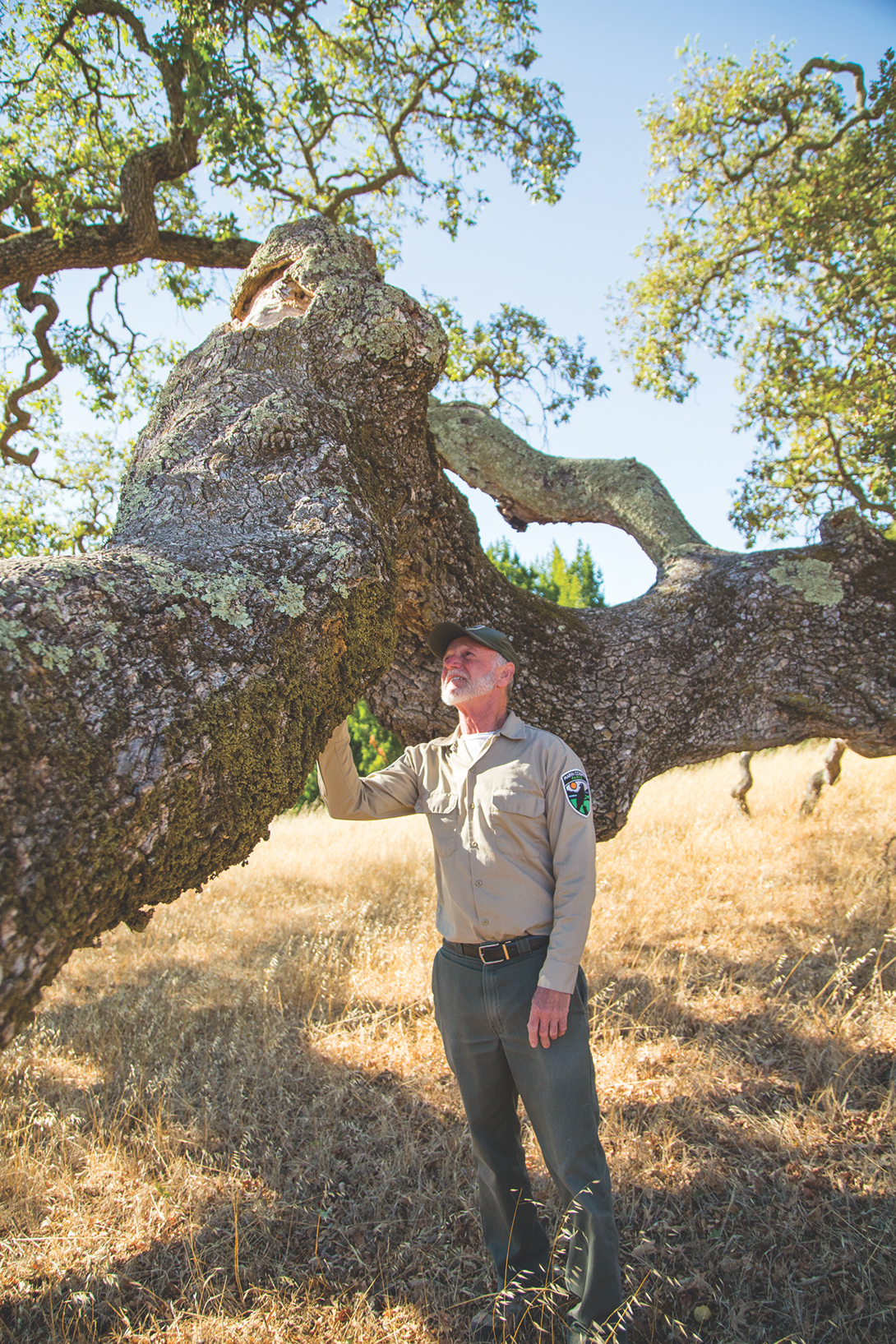
And at Mount Burdell, I also found David Herlocker, who well knows the stories that oaks tell and can tell a few of his own. An entomologist by training, Herlocker has been an interpretative naturalist with the county for 16 years, and among his duties, he leads walks that explore the area’s natural features.
On a summer Tuesday, Herlocker showed me the highlights of a four-hour “all about oaks tour” that he leads each fall (October 11 this year; details here). The tour is timed for fall’s abundance of acorns, which Herlocker considers endlessly fascinating clues to oak identification and behavior — they’re the wellspring of life for oaks and all the living creatures that depend on them.
We start at the preserve’s San Andreas Drive gate. Temperatures are predicted to reach into the 90s, and the hikers, bird-watchers, joggers and mountain bikers are out early. Herlocker says, “The beauty of Mount Burdell is its diversity of plant and animal life.” With 1,627 acres and a peak elevation of 1,558 feet, the preserve includes habitats similar to those you might find ranging from the cool coast to warm Sonoma — woodlands, grasslands, savannas, even Marin’s best example of a vernal pool. Oaks of different species dominate many of these habitats.
I ask, “What did this area look like before California was settled by Europeans?” Herlocker says, “Pretty much the same. Big oaks, open spaces, but different grasses, of course. In the valley bottoms nearby, the oaks were cleared and orchards went in. But the hills here were mostly left alone.” He points out that changes are taking place now. “There aren’t as many young oaks. Recruitment, as it’s called, or regeneration is low. No one is exactly sure why. Maybe there are too many browsing deer now that the lions and bears that used to prey on them are gone.”
Our first stop, just beyond the entry gate, is in front of a coast live oak, with deep green evergreen leaves draping to the ground so densely that you can barely see the thick trunk and branches. Coast live oak (Quercus agrifolia) is the second-most abundant tree in Marin, behind the California bay. Herlocker immediately checks for acorns forming. “Not many. Acorns are mysterious. Some years there are many, other times hardly any.” When acorns form in unusual abundance, it’s called masting, and there are no foolproof predictors of the phenomenon.
In the interest of time, we drive up the main trail, a rutted dirt road. Herlocker drives slowly, creeping past the bird-watchers to keep down the dust. We pass large oaks and bay trees, shading a lush undergrowth of honeysuckle, hazelnut, and poison oak.
At the top of a ridge, one of my California favorite scenes unfurls: golden grass — yes, that pesky Euro-import — and well-spaced oaks. It’s a wide-screen effect like you’d see in one of those classic 1950s black-and-white Westerns. This is an oak savanna, defined as a grassland with a scattering of trees, elementally simple in the number of components.
At the top of the hill, we reach the trees, get a closer look, and see that the habitat is far from simple. It is full of life and variety. This is the oak’s domain — actually the domain of multiple oak species. There’s the coast live oak, the valley oak (deciduous, tall, sculptural, sweeping branches, checkerboard trunk), and even a few black oaks (deciduous, with bright, shiny, big leaves). Joining in are bay trees, in the watercourses, and buckeyes, their leaves turning brown well ahead of fall, which is a defensive shutdown strategy against the dry conditions.
Herlocker points out examples of the oaks’ web of life. The mature trees have many cavities that birds and insects use. An oriole nest hangs like a loose sack from a branch in a valley oak; the bird wove it from fibers shredded from a tarp. In mid-story, Herlocker would say, “I hear a lazuli bunting” — or an oak titmouse or ashthroated flycatcher. We never see the birds.
Herlocker leads the way to a massive valley oak and says, “This tree was around when the Civil War started.” He estimates that it’s 300 years old, with a diameter of five to six feet. It’s struggling now. Recently a limb as large as most trees split off, but even lying on the ground, it maintains a lifeline to the trunk. Despite its terminal condition, the tree is full of life. A close look reveals hundreds of holes drilled into the trunk by acorn woodpeckers. This is their “granary tree,” where the birds store acorns in their own personal pantry. There are also hundreds of smaller holes, which Herlocker says were formed by wood-boring beetles as they left the trunk.
Nearby we see another part of life: ghostly, sun-bleached remains of victims of sudden oak death. The pathogen was discovered in Marin County (“ground zero”) in the mid-1990s and has spread through forests of Northern and Central California, killing more than a million trees. Herlocker says the current drought has slowed the spread of the disease, which is worse in wet years. He puts it in perspective: “A healthy forest is a mosaic of species, living and dead.”
To get to our final stop, we bump along the trail for another half mile to Hidden Lake, actually a vernal pool, one of those temporary ponds that fills up in winter and spring and usually dries up in summer. In early summer it was totally dry, but its bottom was lined with an assortment of plants specifically adapted to the quirky boom-or-bust conditions.
Here in the preserve’s drier eastern half is a crossroads of diverse natural habitats. Herlocker attributes it to “Marin’s scrambled climates” — different microclimates and soil conditions close together. The trees are scrambled too. Edging the pool are five different species of oak that have found the right conditions: live oaks, a particularly “stately” valley oak and three less prevalent types. Blue oak (Quercus douglasii) is deciduous, with small, bluish leaves that absorb less heat, which allows the tree to grow in hotter, drier places. Black oak prefers shaded protected spots. Oregon oak (Quercus garryana) prefers, well, Oregon. Near the southern edge of its range, Herlocker calls attention to its shiny, dark green leaves and the “intricacy of the branching.”
“Oaks are promiscuous,” is how Herlocker explains the interesting phenomenon going on here that most of us would otherwise miss. In this botanical melting pot, the proximity of diverse habitats encourages cross-pollination (wind scatters the pollen) and the creation of hybrids — such as an oak offspring, sprouting from an acorn, that looks a bit like both its parents, say, blue oak and valley oak.
Leaving the pool area, we almost step on a two-inch oak seedling fighting for space in the grass. It’s a hybrid. Even Herlocker can’t identify exactly what it is or its parentage. Whatever it is, this seedling tells a story of the determination of oaks in the face of development, pathogens, drought. I can’t help but think that they’ll be around when most everything else is long gone.
This article originally appeared in Marin Magazine’s print edition with the headline: “Oak Stories”.

